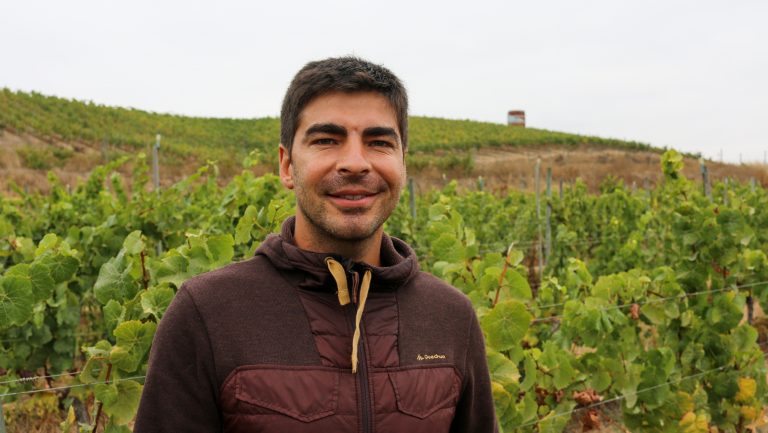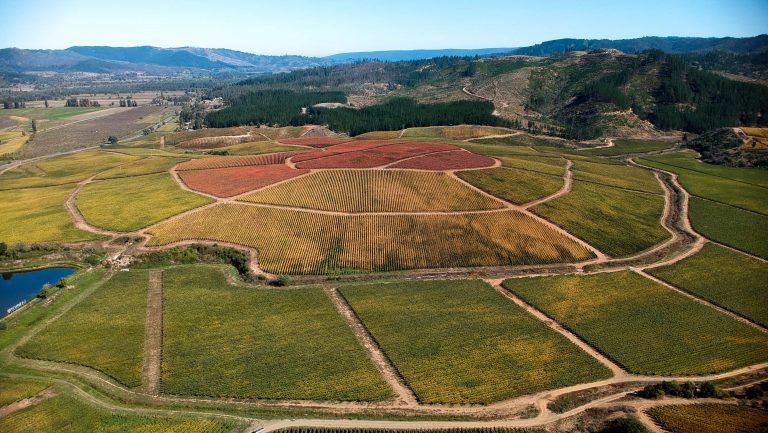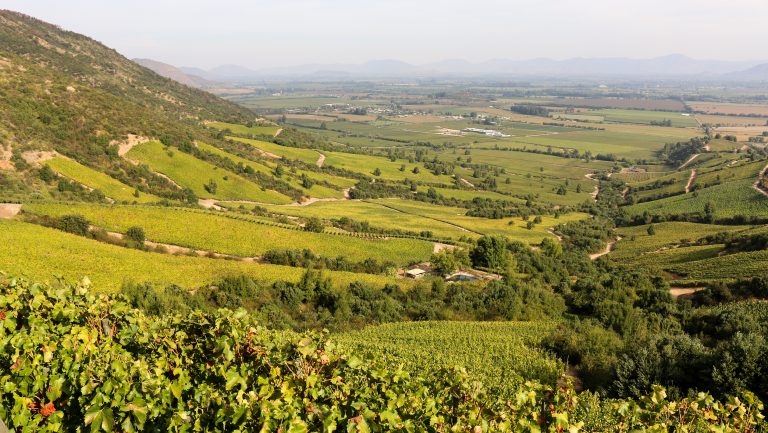The creation of four new appellations in Chile was officially announced in May 2018, following publication in the Official Journal of the Republic of Chile, a periodical that formalizes the country’s new laws. Lo Abarca, Licantén, Apalta, and Los Lingues are now recognized as denominaciónes de origen (DOs), and as such, their names can be displayed on the labels of wines produced with grapes—a minimum of 85 percent—from the respective regions.
Here’s what you need to know about the new DOs:
Lo Abarca DO
The Lo Abarca DO comprises 44.5 hectares. Key varieties in the DO are Sauvignon Blanc, Sauvignon Gris, Riesling, Gewürztraminer, Pinot Noir, Syrah, and Grenache. Lo Abarca is located in the San Antonio Valley in the region of Aconcagua; its climatic designation is Costa.

Don’t miss the latest drinks industry news and insights. Sign up for our award-winning newsletters and get insider intel, resources, and trends delivered to your inbox every week.
This DO was pioneered in 2000 by winemaker María Luz Marín of Casa Marín, who planted the area’s first vineyard just 4 kilometers from the Pacific Ocean. One of Chile’s coolest coastal wine regions, Lo Abarca has a unique combination of calcareous and granitic soils on the slopes surrounding the village.

“It’s a very radical area,” says second-generation Casa Marín winemaker Felipe Marín, adding that the cool temperatures create challenging conditions for grape growing. “Our yields are very low, and we have a very good concentration of flavors and acidity,” he says. “The wines here are unique and characteristic of Lo Abarca.”
Casa Marín is currently the only producer in the Lo Abarca DO. Its wines are acclaimed for their distinctive aromatics and razor-sharp acidity. The small village of Lo Abarca has become synonymous with the Marín family and is filled with colourful mosaics designed by María Luz’s sister, Patricia Marín, have become an added tourist attraction.
Licantén DO
The Licantén DO is made up of 124 hectares. Cabernet Sauvignon, Carménère, Merlot, Syrah, Malbec, Pinot Noir, Cabernet Franc, Petit Verdot, and Carignan are the key varieties. Licantén is located in the Teno Valley in Curico, which is part of the Central Valley; its climatic designation is Costa.
There is only one producer in the in the region of Licantén—La Ronciere. Its large vineyard was planted in the subregion of Idahue in 2012, after the producer made a two-year search for a unique terrain during which he dug over 1,000 exploratory soil pits.
“Idahue has a very particular temperature, soil, air movement, and sun exposure,” says Alejandro Orueta, La Ronciere’s CEO. “It’s 24 kilometers from the sea, but the coastal influence isn’t [as cold] as other places in Chile, and that’s why we only have red varieties.” The most notable characteristic of the area, he says, is that there are four very defined soil types: llicorella, lutites, gravel, and clay. “This is what makes it a very unique vineyard in Chile.”

Apalta DO
The largest and perhaps the best known of the new DOs, Apalta has been lauded for producing excellent quality red blends since the 1990s. It boasts some of Chile’s most expensive labels.
There are 1,007 hectares in the Apalta DO. Apalta’s key varieties are Cabernet Sauvignon, Carménère, Syrah, Malbec, Merlot, Petit Verdot, Mourvèdre, and Grenache. The region is is located in Colchagua, which is part of the Rapel region of the Central Valley; its climatic designation is Entre-Cordilleras. Notable producers in the DO include Lapostolle, Montes, Neyen, Santa Rita, Ventisquero, and Las Niñas.
“We’ve been working since the ’90s to achieve a DO for Apalta,” says Aurelio Montes Jr., of Montes winery, which, along with the neighboring Lapostolle winery, spearheaded the DO campaign. The Apalta Valley is a completely different area from the rest of Colchagua and has exceptional conditions for certain grapes.”
The horseshoe-shaped valley is sheltered to the north, east, and west by hillsides and encompasses vineyards on the valley floor, where Cabernet Sauvignon and Carménère thrive in heavier clay soils. Hillside vineyards are also cultivated in poorer, granitic soils, which are increasingly being planted with the Rhône varieties—Syrah, Mourvèdre, and Grenache.
Los Lingues DO
The Los Lingues DO is composed of 492 hectares; its key varieties are Carménère, Cabernet Sauvignon, Cabernet Franc, Malbec, Merlot, Petit Verdot, Mourvèdre, Grenache, Syrah, and Tempranillo. Los Lingues is in Colchagua, in the Rapel region of the Central Valley; its climatic designation is Andes. Notable producers in the DO include Koyle Family Winery, Siegel, and Casa Silva.
Cristóbal Undurraga, the winemaker for Koyle, has 80 hectares planted in Los Lingues and says that the most important aspect of his family’s production is that their vines are located in the foothills of the Andes Mountains, which influences the climate and soils. “But,” he adds, “there’s lots of difference within the DO—especially between the lower parts versus the foothills.”
Vineyard locations vary, but the Los Lingues region is primarily associated with soils of volcanic origin, with a mix of clay, basalt, and colluvial rocks. The Mediterranean climate, with warm, sunny days followed by cool evening breezes from the mountains, has led to the region being predominantly devoted to red wine production, with Bordeaux varieties most popular.
Although wine production is relatively new in the area, Los Lingues is a historical region and home to Chile’s oldest estancia, or cattle ranch—Hacienda Los Lingues—which was established in the late 16th century.
Moving Forward
Chile’s appellation system has been criticized for being politically rather than geographically, geologically, or climatically defined. Each DO must have an established commune to be considered, a requirement that has rendered well-known wine regions, like Quebrada Seca in Limarí, invalid.
However, Joaquín Almarza Serrano, the head of vineyards at Chile’s agriculture department, suggests that these four new DOs have been developed with the intention of creating a “clearer differentiation of wines reflecting a distinctive terroir.”
Serrano explains that the 2012 climatic designations—Andes, Entre Cordilleras, and Costa—are designed to work within the existing framework of the DOs (both the climatic designation and DO can appear on the label) to mitigate the problem. “The incorporation,” he says, “of climatic factors associated with the influence of the Pacific Ocean, the intermediate depression of the transversal valleys, and the effect of the Andes Mountains highlights the differences in the longitudinal division of our country.” Within the Colchagua DO, for example, all three climatic influences and designations exist. A wine label, says Serrano, will display the climatic designation as a way to help consumers “differentiate and identify wines according to their geographical characterization.”
The smaller dimensions of these new DOs (both Lo Abarca and Licantén are single-producer regions) have also been welcomed by many in Chile’s wine community as a step in the right direction. “Our DOs were too big,” says Aurelio Montes Jr. “They don’t represent the real potential of each one. These new DOs mean a lot for the industry—it’s a first step. Now it depends on us to show their potential.”
María Luz Marín, who has campaigned for DO status for Lo Abarca since 2008, is positive Chile is moving forward in its appellation system. “I believe this marks the beginning of a new era in Chilean vitiviniculture,” she says, “showing that we are a country with a diversity of climates, soils, and spectacular geography. We must start talking about places and specific regions instead of grape varieties—and show that our premium wines are distinctive and unrepeatable.”

Dispatch
Sign up for our award-winning newsletter
Don’t miss the latest drinks industry news and insights—delivered to your inbox every week.
Amanda Barnes is a British wine writer who since 2009 has been based in South America, where she specializes in the wines and regions of Argentina, Chile, Brazil, and Uruguay and writes the South America Wine Guide. Ever footloose, she is currently on a mission to travel Around the World in 80 Harvests.






